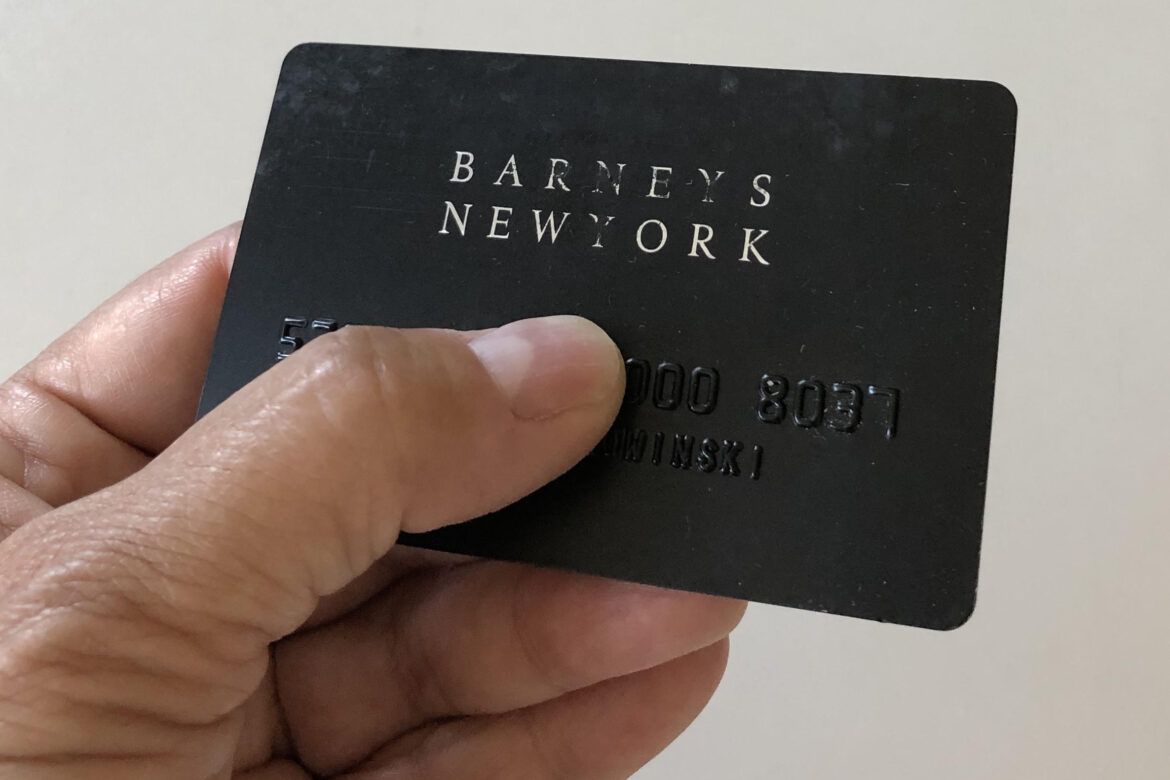The End of Analog Shopping for Fun
I think I can get rid of this card now.
The first thing I bought with my own money at Barney’s was a navy-blue dress. I was 22, ready to join the workforce. This was the early 1980s and fashion was hideous – though in retrospect the style of that decade, like all the ones before it, has now become a kind of campy nostalgia. I turned my nose up at the outfits worn by the legions of women storming the streets with their power shoulders and sneakers, streaks of contour makeup making a diagonal stripe down their cheeks. How gaudy I thought. Yes, I was a snob and I’m not going to apologize for it. It was as simple as this. I liked nice things and didn’t want to look like everyone else. But I will say that I now have an understanding of how disdain for the middle class became such a polarizing, political issue. I was surrounded by like-minded elitists and high-brow art snobs.
Shopping was one of the big city pleasures that made Manhattan living so enjoyable for people like me and my friends – single women and gay men who came of age in the 1970s, a generation notorious for vacant self-absorption. And especially for the ones who came from somewhere else. Here you could reinvent yourself.
Sometimes I’d meet a friend on a Saturday morning, and we’d head uptown when the stores were quiet when we were well-rested and had energy. We’d make sure to wear clothes (and shoes) that were easy to get in and out of so we could try things on. And gut-controlling underwear. Occasionally we would try on outrageous couture because it was too tempting not to. I’m sure the sales staff loved us. Too bad there were no smartphones back then. There could have been some interesting selfies. Though I preferred the original Barney’s Chelsea location, going up to Madison Avenue also meant that we could hit Bergdorf’s too. And then we’d have lunch. Nothing fancy. Usually, we would find a coffee shop, when places like that, along with corner pizzerias, were a dining staple in New York. Before another generation’s palate altered food options. Either way, we had some disposable income, were at the height of our careers, and didn’t feel guilty for selfish indulgence. We didn’t have to be obscenely wealthy to enjoy a little luxury now and then.
Speaking of sales staff, in those days one could make a living in retail. There were people in these stores that had been there for years and seeing their familiar faces made buying things all the more pleasant. They knew the merchandise and they knew your style better than any algorithm. And you could share a laugh. Like the time a nervous dachshund took a dump on the pale carpeted floor of the 4th-floor shoe department, barely missing the tissue paper coming out of the stacks of empty shoeboxes. Or worse, the scattered shoes that came out of those boxes.
Finding expensive but fabulous clothes that made you feel wonderful when wearing them was like a hunt for big game. Finding them on sale was even better. And though Barney’s was famous for their annual warehouse sales, I never had the patience to rummage through the racks, pushing and shoving the other aggressive bargain hunters. Again, there’s that disdain for the masses. I grew up with the original Filene’s Basement in Boston, a trip with purpose into the city that my mother enjoyed. But being tiny, she always found amazing deals. I never had any luck at the warehouse sales. When you’re the most common shoe size – 7.5, average height and build – all that would be left would either be ugly, impractical or both.
Design details, unusual color, unique silhouette, impeccable fit were what made these things special. And quality. I still have a couple of cashmere sweaters made in Scotland that are in great condition – 25 years later. Okay, I have them folded up nicely in an airtight box with lavender sachets. But sorry, Uniqlo knockoffs just can’t compare. The fit is more than a little snug now but I’m reluctant to part with them, convinced they’ll be fine when I lose 20 pounds.
It’s strange to think of this kind of shopping as something from a bygone era because it doesn’t seem like that long ago or that it would end so abruptly. A shift in consumer behavior that was already underway has been amplified by a pandemic lockdown. Now the idea of leisurely shopping – in a fancy store or cute boutique – is unthinkable. I buy online now too but to me, it will never be as much fun as those Saturdays. These days I live in Los Angeles where t-shirts and jeans are an everyday uniform, as constant as the weather. But I still want them to be of good quality, all cotton, and fit well regardless of the fact that I should be too old to care. Trying to find perfection online often leads to disappointment. The pictures don’t let you feel the fabric. No matter how much measuring oneself to the garment dimensions, your purchase can still result in armholes too small, sides not tapered enough, poor stitching, and so many other letdowns that you can either accept or face the hideous task of returning. And starting your search all over again.
I often think that in the future none of this will matter. The way things are going we may soon be scavenging around looking for scraps dressed in leaves and bark. No, I take that back. There won’t be any trees left so we’ll have to wear makeshift frocks of used plastic bags and industrial detritus. In that case, maybe I’d better hold on to this card. It could come in handy as a spatula or repurposed as some other survival tool while reminding me of another time.
